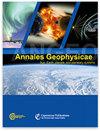Analysis of diurnal, seasonal and annual variations of fair weather atmospheric potential gradient at reduced number concentration of condensation nuclei from long-term measurements at Świder, Poland
IF 1.9
4区 地球科学
Q3 ASTRONOMY & ASTROPHYSICS
引用次数: 0
Abstract
Abstract. The ground-level atmospheric potential gradient (PG) has been measured with a radioactive collector method in Stanisław Kalinowski Geophysical Observatory in Świder (52.12° N, 21.23° E), Poland, for several decades. Long-term measurements analysed previously revealed rather typical behaviour in the diurnal and seasonal variations of the PG of a land station controlled by pollution. Observation of the potential gradient at such a station usually show a maximum at local winter months which are mostly affected by anthropogenic pollution. The 1965–2005 series has been newly analysed to describe the Świder PG variations in greater detail, also in connection with an analysis of simultaneous measurements of condensation nuclei measured at 6, 12, 18 UT. An attempt is made to calculate the diurnal and seasonal variations at condensation nuclei number concentrations below 10000 cm-3. There is a decrease of the PG in the diurnal variation by up to 11 % in the winter, and no significant change in the summer. The reduction in the annual variation is 11–26 % with the biggest difference in February. In the summer months, this difference is negligible. Such differences can be predicted with a simplified model of electrical conductivity including the aerosol composition of water soluble and soot particles, the main components of continental aerosol. With this model we obtained changes in the conductivity and the PG in up to 30 % in the winter, and 6 % in the summer. Despite the efforts to minimise the aerosol effect on the PG, the character of the PG seasonal and annual variation preserves its character with a maximum in the Northern Hemisphere winter and the minimum in the summer.根据在波兰圣韦德的长期测量结果,分析在凝结核数量浓度降低时晴天大气势梯度的昼夜、季节和年度变化情况
摘要几十年来,波兰圣韦德(北纬 52.12°,东经 21.23°)的 Stanisław Kalinowski 地球物理观测站一直使用放射性收集器方法测量地面大气电势梯度(PG)。之前进行的长期测量分析表明,受污染控制的陆地观测站 PG 的昼夜和季节变化具有相当典型的特征。在这样的站点观测到的电位梯度通常在当地冬季月份达到最大值,而这些月份主要受到人为污染的影响。对 1965-2005 年的序列进行了新的分析,以更详细地描述更广泛的 PG 变化,同时还分析了在 6、12、18 UT 同时测量的凝结核。尝试计算凝结核数量浓度低于 10000 cm-3 时的昼夜变化和季节变化。在冬季,昼夜变化中的 PG 下降了 11%,而在夏季则没有明显变化。年变化的降幅为 11-26%,二月份的差异最大。在夏季,这种差异可以忽略不计。这种差异可以用一个简化的电导率模型来预测,该模型包括大陆气溶胶的主要成分--水溶性颗粒和烟尘颗粒。通过该模型,我们得出冬季电导率和 PG 的变化可达 30%,夏季为 6%。尽管我们努力将气溶胶对 PG 的影响降到最低,但 PG 的季节和年度变化特征仍然保持不变,即北半球冬季最大,夏季最小。
本文章由计算机程序翻译,如有差异,请以英文原文为准。
求助全文
约1分钟内获得全文
求助全文
来源期刊

Annales Geophysicae
地学-地球科学综合
CiteScore
4.30
自引率
0.00%
发文量
42
审稿时长
2 months
期刊介绍:
Annales Geophysicae (ANGEO) is a not-for-profit international multi- and inter-disciplinary scientific open-access journal in the field of solar–terrestrial and planetary sciences. ANGEO publishes original articles and short communications (letters) on research of the Sun–Earth system, including the science of space weather, solar–terrestrial plasma physics, the Earth''s ionosphere and atmosphere, the magnetosphere, and the study of planets and planetary systems, the interaction between the different spheres of a planet, and the interaction across the planetary system. Topics range from space weathering, planetary magnetic field, and planetary interior and surface dynamics to the formation and evolution of planetary systems.
 求助内容:
求助内容: 应助结果提醒方式:
应助结果提醒方式:


